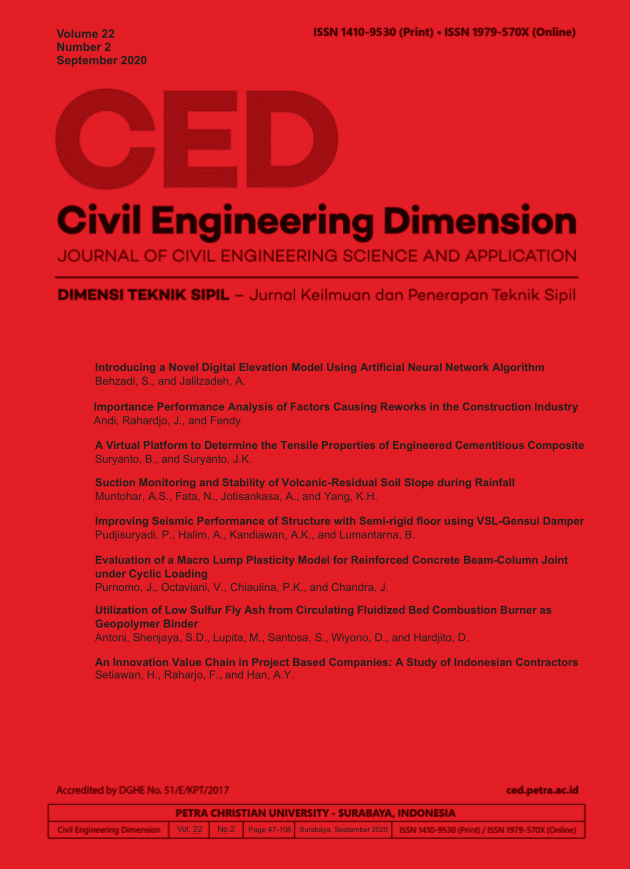A Virtual Platform to Determine the Tensile Properties of Engineered Cementitious Composite
DOI:
https://doi.org/10.9744/ced.22.2.58-66Keywords:
ECC, flexural test, Java Script, online calculator, tensile property, quality controlAbstract
The four-point flexural test is now making headway as an alternative laboratory investigative technique for determining the tensile properties of Engineered Cementitious Composite (ECC) to the more traditional, direct/uniaxial tensile test. As the fundamental mechanics of ECC specimens tested in four-point flexure are well understood, it is possible to develop a simple relationship between flexural test results and the tensile properties of this cement composite. This paper extends this development and aims to provide accessible and quick calculation of the tensile properties of ECC via a virtual test environment. To this end, attention is directed towards the test configurations developed earlier at Heriot-Watt University, the University of Michigan, and Sepuluh Nopember Institute of Technology. In this paper, the technical background employed in creating the virtual environment and the computer implementation using the JavaScript programming language are presented. The prototype virtual environment is freely available via the Internet at https://ecc-calculator.netlify.app/.References
Li, V.C., Engineered Cementitious Composites (ECC)–Material, Structural, and Durability Performance, Concrete Construction Engi¬neer¬ing Handbook, Nawy E.G. (ed.), CRC Press, pp. 24-1-24-46, 2008.
Kanda, T., Tomoe S., Nagai, S., Maruta, M., Kanakubo, T., and Shimizu, K., Full Scale Processing Investigation for ECC Precast Structural Element, Journal of Asian Archi-tec¬ture and Building Engineering, 5(2), 2006, pp. 333–340.
Suryanto, B., Wilson, S.A., and McCarter, W.J., Self-healing of Micro-Cracks in Engi-neered Cementitious Composites, Civil Engi-neering Dimension, 17(3), 2015, pp.187–194.
Suryanto, B., Tambusay, A., and Suprobo, P., Crack Mapping on Shear-critical Reinforced Concrete Beams using an Open-Source Digi¬tal Image Correlation Software, Civil Engi¬neering Dimension, 19(2), 2017, pp. 93–98.
Fukuyama, H. and Suwada, H., Experimen-tal Response of HPFRCC Dampers for Structural Control, Journal of Advanced Con¬crete Technology, 1(3), 2003, pp. 317–326.
Fukuyama, H., Application of High Perfor-mance Fiber Reinforced Cementitious Com-posites for Damage Mitigation of Building Structures, Journal of Advanced Concrete Technology, 4(1), 2006, pp. 35–44.
Kunieda, M. and Rokugo, K., Recent Pro-gress on HPFRCC in Japan, Journal of Advanced Concrete Technology, 4(1), 2006, pp. 19–33.
Kanda, T., Nagai, S., Maruta, M., and Yama-moto, Y., New High-rise R/C Structure using ECC Coupling Beams, Proceedings of the 2nd International RILEM Conference on Strain Hardening Cementitious Composites, Rio de Janeiro, Brazil, 2011, pp. 12–14.
Kanda, T., Kanakubo, T., Nagai, S., and Maruta, M., Technical Consideration in Pro-ducing ECC Pre-cast Structural Element, Proceedings of the International RILEM Work¬shop on High Performance Fiber Rein-forced Cementitious Composites in Structural Applications, 2006, pp. 229–242.
Kanakubo, T., Tensile Characteristics Eva-luation Method for Ductile Fiber-reinforced Cementitious Composites, Journal of Ad-vanc¬ed Concrete Technology, 4(1), 2006, pp. 3–17.
Matsumoto, T., Wangsiripaisal, K., Haya-shikawa, T., and He, X., Uniaxial Tension-Compression Fatigue Behavior and Fiber Bridging Degradation of Strain Hardening Fiber Reinforced Cementitious Composites, International Journal of Fatigue, 32(11), 2010, pp. 1812–1822.
Suryanto, B., Wilson, S.A., McCarter, W.J., and Chrisp, T.M., Self-Healing Performance of Engineered Cementitious Composites under Natural Environmental Exposure, Advances in Cement Research, 28(4), 2016, pp. 211–220.
Kobayashi, K., Anh, D.L., and Rokugo, K., Effects of Crack Properties and Water-Ce-ment Ratio on the Chloride Proofing Perfor-mance of Cracked SHCC Suffering from Chloride Attack, Cement and Concrete Com-posites, 69, 2016, pp. 18–27.
Suryanto, B., Buckman, J.O., Thompson, P., Bolbol, M., and McCarter, W.J., Monitoring Micro-crack Healing in an Engineered Ce-men¬titious Composite using the Environ-men¬tal Scanning Electron Microscope, Mate-rials Characterization, 119, 2016, pp.175–185.
Qian, S. and Li, V.C., Simplified Inverse Method for Determining the Tensile Strain Capacity of Strain Hardening Cementitious Composites, Journal of Advanced Concrete Technology, 5(2), 2007, pp. 235–246.
Qian, S. and Li, V.C., Simplified Inverse Method for Determining the Tensile Strain Properties of Strain Hardening Cementitious Composites (SHCC), Journal of Advanced Concrete Technology, 6(2), 2008, pp. 353-363.
Suryanto, B., Reynaud, R., and Cockburn, B., Sectional Analysis of Engineered Cemen-titious Composite Beams, Magazine of Con-crete Research, 70(22), 2018, pp. 1135–1148.
Suryanto, B., Cockburn, B., Han, A.L., and McCarter, W.J., An Alternative Method for Determining Tensile Properties of Engi-neering Cementitious Composites, Procedia Engineering, 171, 2017, pp. 584–591.
Tambusay, A., Suryanto, B., and Suprobo, P., Digital Image Correlation for Cement-based Materials and Structural Concrete Testing, Civil Engineering Dimension, 22(1), 2020, pp. 6–12.
Suryanto, B., Mechanics of High Performance Fiber Reinforced Cementitious Composite (HPFRCC) under Principal Stress Rotation, Ph.D Thesis, University of Tokyo, 2009.
Suryanto, B., Nagai, K., and Maekawa, K., Modeling ad Analysis of Shear-Critical ECC Members with Anisotropic Stress and Strain Fields, Journal of Advanced Concrete Tech-nology, 8(2), 2010, pp.239–258.
Suryanto, B., Nagai, K., and Maekawa, K., 2010, Seared-crack Modeling of R/ECC Mem-branes incorporating an Explicit Shear Transfer Model, Journal of Advanced Con-crete Technology, 8(3), 2020, pp.315–326.
Downloads
Published
How to Cite
Issue
Section
License
Authors who publish with this journal agree to the following terms:- Authors retain the copyright and publishing right, and grant the journal right of first publication with the work simultaneously licensed under a Creative Commons Attribution License that allows others to share the work with an acknowledgement of the work's authorship and initial publication in this journal.
- Authors are able to enter into separate, additional contractual arrangements for the non-exclusive distribution of the journal's published version of the work (e.g., post it to an institutional repository or publish it in a book), with an acknowledgement of its initial publication in this journal.
- Authors are permitted and encouraged to post their work online (e.g., in institutional repositories or on their website) followingthe publication of the article, as it can lead to productive exchanges, as well as earlier and greater citation of published work (See The Effect of Open Access).











